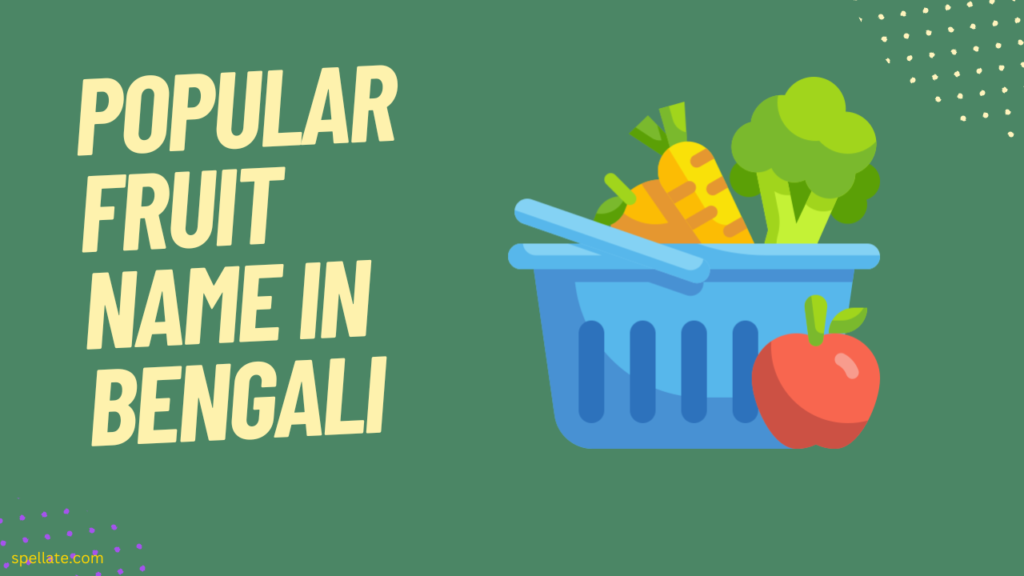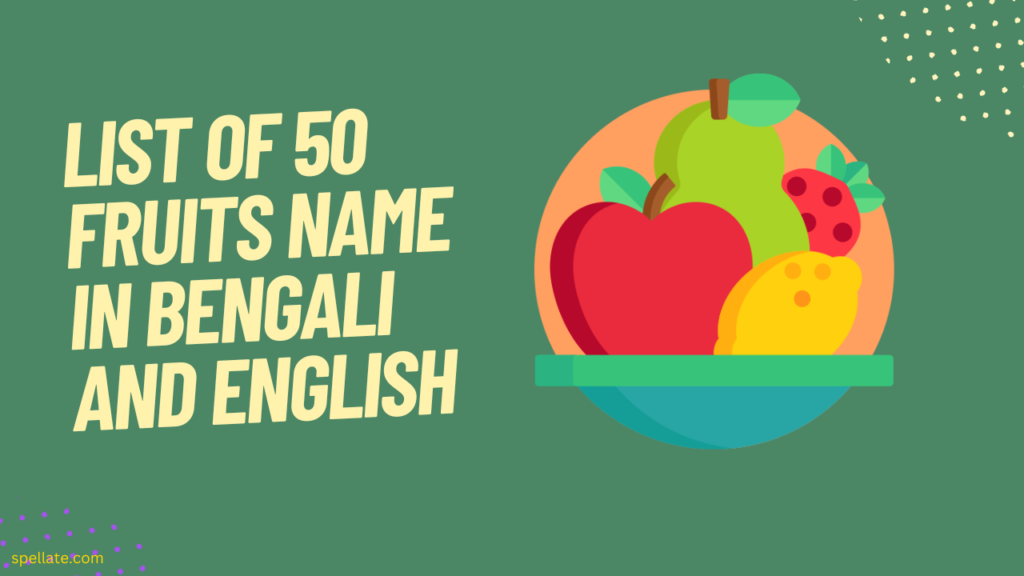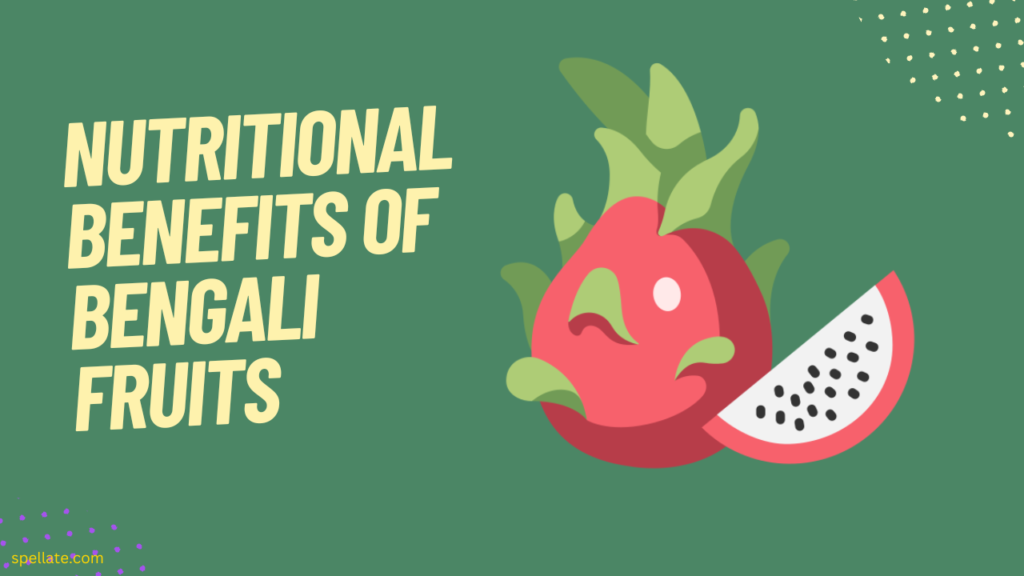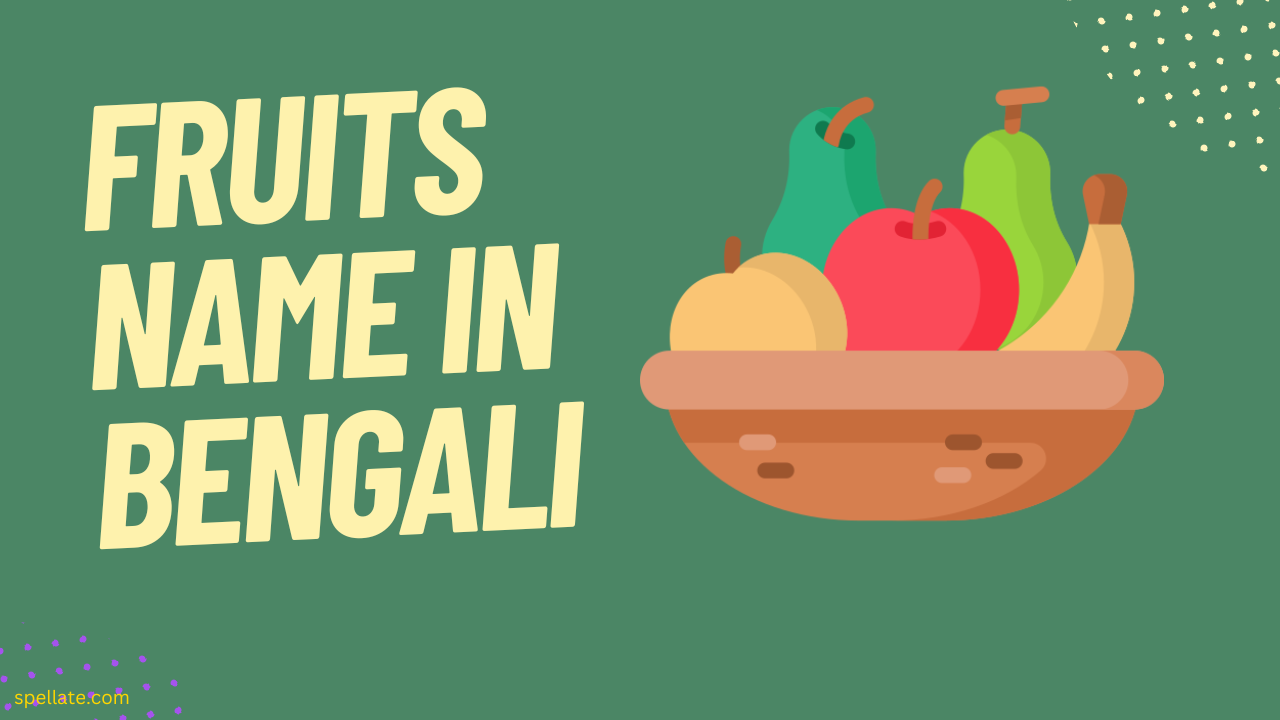If you’re looking to learn about fruits name in Bengali, you’ve come to the right place! Bengali, also known as Bangla, is the official language of Bangladesh and is also spoken in the Indian states of West Bengal, Tripura, and Assam.
Fruits are an important part of Bengali cuisine and culture, and knowing their names in Bengali can be useful if you’re traveling to a Bengali-speaking region or simply want to expand your vocabulary.
Some common fruits name in Bengali include “aam” (mango), “litchi” (lychee), “kathal” (jackfruit), “jam” (guava), “peyara” (pear), “lebu” (lemon), “kola” (banana), “kamranga” (star fruit), “tomato” (tomato), and “amra” (hog plum).
In Bengali, fruits are often eaten fresh or used in dishes such as chutneys, pickles, and desserts. Bengali cuisine is known for its use of bold and aromatic flavors, and fruits play a significant role in achieving these flavors.
Learning the names of fruits in Bengali can not only help you better understand the cuisine and culture of the region but also enhance your communication skills with Bengali speakers.
Popular Fruit Name in Bengali

Bengali is a rich and vibrant language that has evolved over the centuries. With a population of more than 250 million speakers worldwide, it is one of the most widely spoken languages in the world. One of the many fascinating aspects of Bengali culture is its unique naming conventions for fruits. Bengalis have their own names for most fruits, which are different from the common English names. Here are some popular fruit names in Bengali
1. Aam (আম) – Mango:
Mango is considered the “king of fruits” in many cultures, and it is no different in Bengali cuisine. Mangoes are widely grown in Bangladesh and West Bengal and are a popular fruit during the summer season. In Bengali, mango is called “aam”, and it is used in a variety of dishes, both sweet and savory. Some popular Bengali dishes made with mango include “aam panna” (a refreshing drink made with mango pulp), “aam doi” (a sweet yogurt made with mango puree), and “aam shorbot” (a sweet mango drink). Mangoes are also used in chutneys, pickles, and curries. In Bengali culture, mango is considered a symbol of prosperity and is often presented as a gift during weddings and other special occasions.
2. Lichu (লিচু) – Lychee:
Lychees are a popular fruit in Bengali cuisine, particularly during the summer season. In Bengali, lychee is called “lichu”, and it is known for its sweet, juicy flavor and soft texture. Lychees are often eaten fresh or used in desserts, such as “lichu kulfi” (a type of Indian ice cream made with lychee pulp) and “lichu malai” (a sweet dish made with lychee pulp and cream). Lychees are also used in drinks, such as “lichu sherbet” (a sweet drink made with lychee pulp and sugar syrup). In Bengali culture, lychee is considered a symbol of love and is often used in romantic poetry and songs.
3. Kathal (কাঁঠাল) – Jackfruit:
Jackfruit is a large, tropical fruit that is commonly used in Bengali cuisine. In Bengali, jackfruit is called “kathal”, and it is known for its unique, sweet flavor and meaty texture. Jackfruit is often used in savory dishes, such as curries and stews, and it is also used in desserts, such as “kathal payesh” (a sweet rice pudding made with jackfruit pulp). In Bengali culture, jackfruit is considered a symbol of fertility and prosperity and is often used in religious ceremonies and rituals.
4. Jam (জাম) – Guava:
Guava is a small, round fruit that is commonly grown in Bangladesh and West Bengal. In Bengali, guava is called “jam”, and it is known for its sweet, fragrant flavor and crunchy texture. Guava is often eaten fresh or used in drinks, such as “jam pani” (a sweet, refreshing drink made with guava pulp) and “jam sharbat” (a sweet drink made with guava pulp and sugar syrup). Guava is also used in chutneys and pickles. In Bengali culture, guava is considered a symbol of health and is often used in traditional medicines for its medicinal properties.
5. Peyara (পেয়ারা) – Pear:
Pear is a fruit that is not as commonly grown in Bangladesh and West Bengal compared to other fruits, but it is still a popular fruit in Bengali cuisine. In Bengali, pear is called “peyara”, and it is known for its sweet, juicy flavor and soft texture.
Pears are often eaten fresh or used in desserts, such as “peyara payesh” (a sweet rice pudding made with pear pulp) and “peyara malai” (a sweet dish made with pear pulp and cream). Pears are also used in chutneys and pickles. In Bengali culture, pear is considered a symbol of friendship and is often presented as a gift to close friends.
6. Lebu (লেবু) – Lemon:
Lemon is a citrus fruit that is commonly used in Bengali cuisine. In Bengali, lemon is called “lebu”, and it is known for its sour, tangy flavor and acidic properties. Lemons are often used in savory dishes, such as curries and stews, and they are also used in drinks, such as “lebu pani” (a refreshing drink made with lemon juice and sugar syrup) and “nimbu pani” (a similar drink made with lime juice).
Lemon juice is also used as a natural preservative in pickles and chutneys. In Bengali culture, lemon is considered a symbol of purification and is often used in religious ceremonies and rituals.
7. Kola (কলা) – Banana:
Banana is a fruit that is widely grown in Bangladesh and West Bengal, and it is a staple in Bengali cuisine. In Bengali, banana is called “kola”, and it is known for its sweet, creamy flavor and soft texture. Bananas are often eaten fresh or used in desserts, such as “kolar payesh” (a sweet rice pudding made with banana pulp) and “kolar malai” (a sweet dish made with banana pulp and cream).
Bananas are also used in savory dishes, such as curries and stews, and they are often fried or roasted and served as a snack. In Bengali culture, banana is considered a symbol of fertility and is often used in religious ceremonies and rituals.
8. Kamranga (কামরাঙ্গা) – Star fruit:
Star fruit, also known as carambola, is a fruit that is commonly grown in Bangladesh and West Bengal. In Bengali, star fruit is called “kamranga”, and it is known for its sweet, tangy flavor and distinctive star shape when sliced. Star fruit is often eaten fresh or used in drinks, such as “kamranga sharbat” (a sweet drink made with star fruit pulp and sugar syrup).
Starfruit is also used in salads and chutneys. In Bengali culture, star fruit is considered a symbol of good luck and is often presented as a gift during weddings and other special occasions.
9. Tomatoes (টমেটো) – Tomatoes:
Tomatoes are a commonly used fruit in Bengali cuisine. In Bengali, tomatoes are called “tomato”, and they are known for their juicy texture and tangy flavor. Tomatoes are used in a variety of dishes, including curries, stews, and salads. They can be cooked or eaten raw and are often used as a base for sauces and chutneys. In Bengali culture, tomatoes are believed to have health benefits and are often consumed for their high levels of vitamins and antioxidants.
You May Also Like
10. Amra (আমড়া) – Hog Plum:
Hog plum, also known as ambarella, is a fruit that is commonly used in Bengali cuisine. In Bengali, hog plum is called “amra”, and it is known for its sour and tangy flavor. Hog plums are often used in chutneys and pickles, and they are also used to make a sweet and sour drink called “amra panna”.
Hog plums are believed to have medicinal properties and are often used to treat digestive issues and skin problems in Bengali culture. In addition, hog plum leaves are used in traditional Bengali medicine for their anti-inflammatory properties.
List of 50 fruits name in Bengali and English

Are you someone who loves to explore fruits from different parts of the world? If yes, then this article is just for you. Here we have compiled a list of 50 fruits name in bengali and English that are commonly found in Bengali cuisine So, let’s dive into the world of exotic fruits.
| No | Bengali Name of Fruits | English Name of Fruits |
| 1 | আম | Mango |
| 2 | আমড়া | Hog Plum |
| 3 | আমরা | Indian Gooseberry |
| 4 | আমসত্ত্ব | Persimmon |
| 5 | আম্বর | Jujube |
| 6 | আরম | Spondias mombin |
| 7 | আপেল | Apple |
| 8 | আবালকমা | Velvet Apple |
| 9 | আম্লকি | Bilimbi |
| 10 | আঙ্গুর | Grapes |
| 11 | আলুবখারা | Wild Almond |
| 12 | আলু | Potato |
| 13 | আলুবখারা | Wild Almond |
| 14 | আলুচাবড়া | Sweet Potato |
| 15 | আলুকলা | Yacon |
| 16 | আলোচ | Starfruit |
| 17 | আলোহজল | Bottle Gourd |
| 18 | আশগোল | Pineapple |
| 19 | আহলেবু | Citron |
| 20 | আঁটি | Carambola |
| 21 | ইলিশ | Hilsa Fish |
| 22 | উখোন | Water Chestnut |
| 23 | উড়খি | Elephant Apple |
| 24 | উদম্বর | Figs |
| 25 | কাঁচা আম | Raw Mango |
| 26 | কাঁঠাল | Jackfruit |
| 27 | কালাভূট | Blackberry |
| 28 | কামরাঙ্গা | Star Fruit |
| 29 | কামরাঙ্গী | Carambola |
| 30 | কারবুজ | Muskmelon |
| 31 | কাষ্ঠাকুল | Wood Apple |
| 32 | কমলা | Orange |
| 33 | কলা | Banana |
| 34 | কলমি | Indian Persimmon |
| 35 | কলমী | Star Apple |
| 36 | কলম্বি | Java Apple |
| 37 | কমলি | Papaya |
| 38 | কমলা | Sweet Orange |
| 39 | কমলালেবু | Lime |
| 40 | কমলিকা | Pineapple |
| 41 | কমলিগাছ | Papaya Tree |
| 42 | কমলিলেবু | Lemon |
| 43 | কমলিলেবু | Lime |
| 44 | কমলিমিষ্টি | Papaya Pudding |
| 45 | করত | Pomegranate |
| 46 | কাগজি লেবু | Citrus aurantifolia |
| 47 | কাঠবেল | Wood Apple |
| 48 | কাদলি | Plantain |
| 49 | কাদম | Malay Apple |
Importance of knowing fruit names in Bengali
Knowing the fruits name in Bengali can be important for several reasons:
Communication: If you are traveling or living in a Bengali-speaking region, knowing the fruit names can help you communicate better with locals. It will make it easier for you to ask for a specific fruit when shopping or ordering food.
Cultural Understanding: Knowing the fruits name in Bengali can also help you better understand Bengali culture. Fruits are an important part of Bengali cuisine and are used in many traditional dishes. Understanding the names of fruits can help you appreciate and enjoy the food more fully.
Health Benefits: Fruits are an important part of a healthy diet and provide essential nutrients and vitamins. Knowing the fruits name in Bengali can help you make healthier food choices and incorporate more fruits into your diet.
Economic Benefits: Bangladesh is one of the largest producers of fruits in the world, and the country is known for its variety of fruits. Knowing the fruit names can help you identify and buy local fruits, supporting the local economy.
Nutritional benefits of Bengali fruits

Bengal is known for its diverse variety of fruits, which not only taste delicious but also offer numerous nutritional benefits. Here are some of the nutritional benefits of Bengali fruits:
Rich in vitamins and minerals: Bengali fruits are a great source of essential vitamins and minerals like Vitamin C, Vitamin A, potassium, and folate. These nutrients are essential for maintaining healthy skin, strong bones, and a healthy immune system.
High in fiber: Many Bengali fruits are high in fiber, which can aid in digestion and help regulate blood sugar levels. Fiber also helps you feel full and satisfied, making it a great addition to a weight-loss diet.
Antioxidants: Many Bengali fruits are high in antioxidants, which protect your cells from damage caused by free radicals. This can help reduce the risk of chronic diseases such as cancer, heart disease, and Alzheimer’s.
Low in calories: Most Bengali fruits are low in calories and high in water content, making them an ideal snack for weight loss. Eating fruits can help you feel full without consuming excess calories.
Final Thoughts
In conclusion, knowing the fruit names in Bengali is essential for anyone who wants to explore the rich culture and cuisine of Bengal. From the popular mangoes and bananas to the lesser-known custard apples and wood apples, the variety of fruits in Bengal is vast and diverse. Apart from being delicious, Bengali fruits offer numerous nutritional benefits such as vitamins, fiber, and antioxidants, making them an important part of a healthy and balanced diet.
By learning the fruit names in Bengali, you can improve your communication with locals, gain a better understanding of the culture, and promote healthier eating habits. So, the next time you visit Bengal, don’t forget to explore the local fruit markets and try out some of the delicious and nutritious fruits that this region has to offer.
FAQs
What are some less common fruits found in Bengal?
Some less common fruits found in Bengal include custard apple, star fruit, wood apple, and hog plum.
Can I find Bengali fruits in other parts of India or the world?
Yes, many of these fruits can be found in other parts of India and some can be found in other parts of the world as well.
Are Bengali fruits used in traditional Bengali cuisine?
Yes, Bengali fruits are commonly used in traditional Bengali cuisine, both in sweet and savory dishes.
What are some popular Bengali dishes made with fruits?
Some popular Bengali dishes made with fruits include aam panna (a mango drink), kathal biryani (jackfruit biryani), kolar bora (banana fritters), and chutney made with various fruits.
How do I incorporate Bengali fruits into my diet?
Bengali fruits can be eaten as a snack, used in smoothies or fruit salads, or incorporated into traditional Bengali dishes. Try experimenting with different recipes and flavors to find new ways to enjoy these nutritious and delicious fruits.
